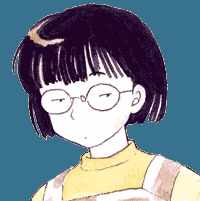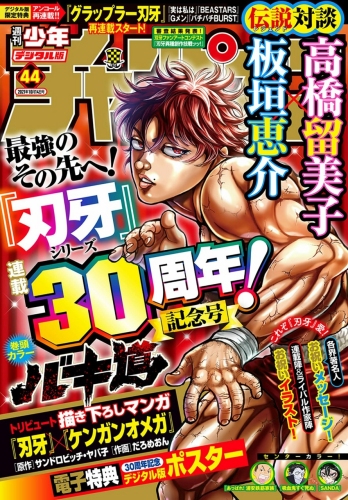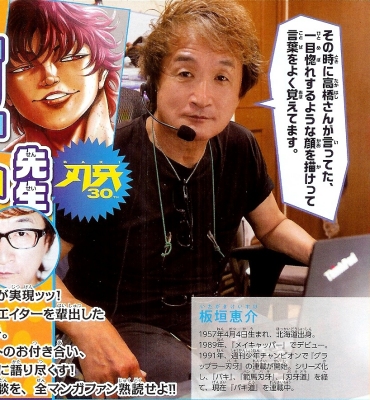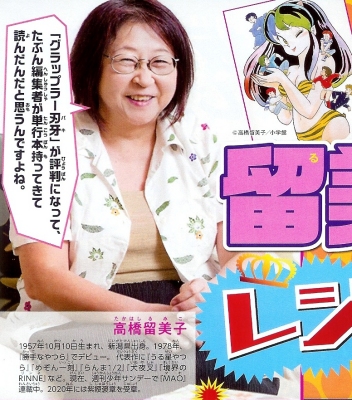


Strong. Beautiful. Strange. Baki's 30th Anniversary
Translation by: Dylan & Harley Acres
I think that many readers are surprised at the pairing of Takahashi-sensei and Itagaki-sensei, but I understand the two of you have been on good terms for a long while. How did you two originally meet?
Itagaki: It was through Gekiga Sonjuku. [1] Takahashi is a first generation member and I'm a sixth generation member. There's a big difference between us though. Gekiga Sonjuku is a manga artist training school that was presided over by Kazuo Koike, the original master of gekiga. [2] There's quite a difference in first generation and sixth generation... about 10 years between our debuts.You're actually the same age, right?
Takahashi: We are the same age.Itagaki: It's no good. When I was a student she was asked to come in as a guest instructor. I remember the first words Takahashi-san said were, "Draw a face that will make you fall in love at first sight."
Takahashi: I have no memory of saying that. I do remember later Itagaki-san retorted "how do you draw the front of a human face?"
Itagaki: I was told I had to draw a picture that was so good it would make someone want to copy it.
Takahashi: Oh is that how it was? (laughs)
When Takahashi-sensei was a student, Ryoichi Ikegami-sensei came as an instructor right? [3]
Takahashi: Yes. The school really was a place where you can go and listen to practical stories from experts in the field. It was helpful. I learned a lot from actual professionals who were involved in the manga industry and how they really do think about drawing every day.Itagaki: Did the head of the school (Kazuo Koike) chat and mess around a lot with the first term group?
Takahashi: Even his chats were usually focused on manga, it was really interesting. How was he with your group?
Itagaki: Most of the lectures and chats were interesting and I loved it.
Takahashi: Koike-san handed out a copy of his original script to everyone, and I remember the story and what happened in the drawings. There was a class where he said, "I wrote this, but the drawing ended up like this!" It's very easy to understand if you explain what you intended and what you intended this sentence to convey. It's like getting the reader to enter the world from the opening and showing them when, where, who and what the characters are trying to accomplish.
Itagaki: That was how it was during my time as well. I remember learning how to do layouts and how good the composition of Tetsuya Chiba's actions scenes were. It was explained using a scene from a match in Ashita no Joe, I was already sure that I was going to draw battle manga, so I had begun to study that. [4]
Takahashi: Chiba-sensei was also a lecturer for us, and he said at the time of depicting a match, he asserted that he would not change the direction of the ring. "Once I set the red corner and the blue corner on the page," he said "I don't move it during the match, you have to be thorough." That was really useful for me.
Itagaki: I heard that from the mouth of Koike-san himself. Because it's boxing there are certain scenes that always get around, but I always draw a scene where two people are switched from a distant shot to a long view, kind of like this. Then you open the window and pull it back again. You have to be conscious to change it up though.
 Takahashi: People will recoil from it if they can’t understand it.
Takahashi: People will recoil from it if they can’t understand it.
Itagaki: I'm still influenced by Chiba-san. There are some of his techniques that I still use to this day. For instance, in a scene where a punch is being thrown, even if it’s a straight shot I’ll use this sort of angle to show it.
Takahashi: That's right.
How did Takahashi-san enter Gegika Sonjuku?
Takahashi: I was invited by a friend of mine to go every week when I was in college (laughs). But I knew of Kazuo Koike from Lone Wolf and Cub, so I joined the school without any hesitation. I don't think there was anything else like a school that taught shonen manga or seinen manga properly. When I entered, what I found to be so revolutionary was that it was easy to understand, and he explained the rationale of manga in a logical way. And I also remember the first thing I heard Koike-sensei say was "The most important thing in manga is the character," and I had never really thought of that until then, but I remember thinking, "That's true." [5]You debuted about a year after that. I think Koike-san must have been very pleased with you.
Takahashi: He was happy. Before my debut, he was the first person to see the manuscript and said, "You can make your debut." He said good luck and I thought "I'll do my best," so I'm very grateful to him. [6]And Itagaki-san took Takahashi-san's class.
Itagaki: That's right, out of all the instructors, she was by far the most popular.When did Takahashi-sensei recognize Itagaki-sensei?
Takahashi: I think my editor brought a book of Grappler Baki when it was becoming popular and I read it. It was a lot of fun. I don’t think I knew you were from Sonjuku at that time?Itagaki: She didn’t know. At Sonjuku's alumnus meeting, after the serialized mangaka were lined up and introduced, someone said, "Takahashi-san wants to talk, can you meet with her?", "Hey, she wants to chat." And I remember we were the same age, we were contemporaries. So, when I first talked to her, she said, "I didn't know you went to Sonjuku."
Takahashi: Oh, that's right.
Do you remember that conversation?
Takahashi: I think I praised you, saying 'this part is interesting' or 'I like this character.' I remember complimenting Baki's face and eyes and thinking he had exactly the kind of eyes a shonen protagonist has to have.Itagaki: That's right. I couldn't draw a beautiful face with eyes that looked toward the future, so I started by copying the painter Keibun Ota. [7] I remember the head of the school (Koike) said if I drew a thousand pieces, I could definitely make my debut. I've always kept a Croquis sketchbook in my pocket so I can draw anywhere. So if I had a little time I would pull it out and begin to draw.

That's when your relationship started.
Itagaki: Pretty much. We would go see women’s pro-wrestling matches or marital arts tournaments together. [8]Takahashi: I invited him to see Miki Maya at the Takarazuka Revue. [9] Also didn't we go see a concert related to the World Cup?
Itagaki: Yeah, we saw B'z and Aerosmith. [10]
Takahashi: I remember my aunt who thought Aerosmith's vocalist looked like Baki's father, Yujiro (laughs).
Itagaki: The concert was outdoors and it was so, so cold. I remember we took a taxi to a cafe in Shinjuku and talked about almost nothing until we closed the place down (laughs).
Takahashi: I didn't get drunk even after having two drinks with a fever. Well, it was fun (laughs). It was fun.
Itagaki: No, Rumiko Takahashi and Keisuke Itagaki are both together but sick and totally quiet. It's a pretty interesting picture.
So you got along.
Takahashi: Yes, we got along well. It’s still funny to talk about.Itagaki: Huff (laughs).
Can we discuss manga?
Takahashi: Sure.Itagaki: Yes, lets. We can discuss a variety of things.
Takahashi: Well, I keep complimenting Inagaki-san's manga (laughs).
Is Inagaki only able to accept praise and not give it? (laughs)
Inagaki: No, it's just that One Pound Gospel is the only one I’ve fully read.Takahashi: That’s reassuring (laughs). That's fine.
Itagaki: (Bitter smile) What kind of boxer would I draw. I liked that the protagonist said stuff like, “oh yeah, no big deal” and was really laid back and wasn’t stoic or anything.
Takahashi: Well, it’s a manga like me.
Itagaki: I was impressed with Takahashi-san’s flavor in that series. Especially how she’s able to draw such an attractive face with so few lines. She has a natural ability to find this perfect balance.
Takahashi: So I'm just a fan of Itagaki (laughs). Baki is a good character, isn't he?
Inagaki: The head of Gegika Sonjuku taught us composition, name, [11] drawing ability, composition, for example, I was told in every class that the character’s hexagon could be big and distorted, that they shouldn’t just wake up and be fully developed. [12]
Takahashi: After all, the character is the most important thing. It's the main thing that matters.
Takahashi-sensei, do you also spend a lot of time developing a character? Creating a character is different than creating a setting.
Takahashi: Mmm, that's right... of course, making only characters doesn't make a manga, so I do think about the setting and other sides of how to make use of their world and so on.Itagaki: A good character can make walking interesting, and so if you have that idea then you've already created an image. You can just stand there with your hand in your pocket and you've already got something. It's a product.
There are some characters that don't go well, right?
Itagaki: That's because the character isn't fully realized, it's imperfect. I think that's what the head of the school used to mean when he would say "the character isn't awake."How do you correct that?
Itagaki: Well, I’ve never really given that much thought so how do I explain it... well, I guess there is a way to do it.Takahashi: Yeah, yeah, yeah.
Itagaki: I add elements while thinking about when people are attracted to me and when I feel attractive. And then, I think, first of all, “what kind of person is this character?” You have to do that first.
Takahashi: Wow, hmm, it’s interesting.
Itagaki: If they are ridiculously "normal" I think that if they are thoroughly so then the character could be compelling. If they are a normal "ordinary person" then it can become unbalanced. However if they are a normal person placed into a crisis then they can potentially rise up.
Takahashi: Hmmmmm.
Takahashi-sensei, is there such a way?
Takahashi: I mean, it's been really helpful to listen to this now.Itagaki: Hahahahaha (laughs).
Takahashi: In my case, it's a reaction, you know? Or, it’s a collaboration, that's what I mean. I think it's quite important to build the reaction of the main character of the story by doing things with the characters around him. Then he has a role to play afterwards. I wonder if that role in the story is clearly defined. There's a lead character, an assistant character, a rival, and each plays an important role, so that's what I like to try. I mean, I don't make characters in the first place. I make them to some extent, but I allow for room for them to explore and grow. I think about what kind of person the character is, why they behave the way they do, what they think about various human situations. That's how I write them.
I asked about the composition earlier, but are there any particular points that you're focused on?
Takahashi: First of all, that it's easy to read. It has to be interesting for the reader. Keeping the reader in mind is the most important aspect. That the story is interesting for them. That it's easy to understand and interesting. I want the reader to feel, "I can see it" rather than "I can read it." You shouldn't "read" the lines. Well, it depends on the manga.Itagaki: (laughs) Yeah, I understand that there are some manga with lines that make the manga interesting to read.
Takahashi: For example, in Ashita no Joe when he fights Wolf Kanagushi, Danpei explains the double cross-counter with a lengthy bit of text.
Itagaki: Yes.
Takahashi: That's was quiet interesting.
Itagaki: It's funny.
Takahashi: That’s an example of a place in manga where reading is the focus.
(laughs)
Itagaki: Uh, yeah, that is, surely (laughs). I have to explain it better. It's not a good explanation but I basically feel that manga is more about seeing than reading.Takahashi: And Baki in particular is a fighting series, so that feeling really makes sense.
Itagaki: I'm wondering if it wouldn't be possible if the content, including the lines of dialogue, didn't come in as soon as you see the imagery. I've always kept in mind that I can finish reading in a breath, and it's better to have a short storyboard/rough, and I'm conscious of making it readable once in a while, but most of the time I want to make it understandable just by looking at it.
Takahashi: Yeah, yeah, that's what I'm talking about. I try to make the dialogue lines as long as possible, but so that they can be read in a single breath. You need to divide it into another balloon if it becomes too long. At the same time, you want to create dialogue that makes you want to continue reading to the next panel, so that when you're told (as the reader) "where" to turn your attention, you turn it there. I want to create something that does that. Anyway, the important thing is readability, yes.
After working on a weekly schedule for so many years, have you ever wanted to quit?
Takahashi: No. Manga is fun.Itagaki: It is, it is. But it's hard doing it every week (laughs).
Takahashi: That's a lie.
Itagaki: Well if you take a break from drawing, you always want to draw again. Do you like drawing? I like drawing, but I don't like it. If I'm told to take a rest, I'll take a rest.
Takahashi: But what if you were told not to draw anymore? (smiles)
Itagaki: ...well, I can't stop because it’s a habit and an instinct at this point. If I was told not to draw anymore, I’d still draw. For sure.
Takahashi: Heh heh heh, is that so? I'm the same way. I think I can't draw more even when I can.
Itagaki: I don't have a feeling that Baki will come to an end, so I'll just continue drawing it forever.
Takahashi: I think that's just fine.
Itagaki: I should answer that better. I'll say I'll draw it until the end.
Takahashi: I really think it’s a great series. Please die at your desk.
Itagaki: I don't like the sound of that (laughs).
Takahashi: It'd be cool (laughs).
Itagaki: No, I don't want to do that (laughs).
Takahashi: I'm just a big fan of Itagaki's.
Footnotes
- [1] Gekiga Sonjuku was a manga "cram school" where Kazuo Koike, the writer of such iconic manga as Lone Wolf and Cub, Crying Freeman and Lady Snowblood helped train a number of manga luminaries before their debuts. Besides Rumiko Takahashi, other Gekiga Sonjuku alumnai include Tetsuo Hara (Fist of the North Star), Yuji Hori (Dragon Quest), Hideyuki Kikuchi (Vampire Hunter D), Keisuke Itagaki (Grappler Baki) and Marley Caribu (Old Boy).
- [2] "Gekiga" (劇画) or "dramatic pictures" is a style of manga strongly connected to the work of Takao Saito (斎藤隆夫), Sanpei Shirato (白土三平), Ryoichi Ikegami (池上 遼一), Yoshiharu Tsuge (つげ義春), Yoshihiro Tatsumi (辰巳ヨシヒロ) and Shigeru Mizuki (水木しげる) among others.
- [3] Ryoichi Ikegami (池上遼一) is by far Takahashi's biggest influence and favorite artist as she has professed many times. His work includes Crying Freeman (クライング フリーマン), Sanctuary (サンクチュアリ) and Wounded Man (傷追い人).
- [4] Rumiko Takahashi has often spoken of her fondness for Ashita no Joe and its artist Tetsuya Chiba.
- [5] Kazuo Koike's most important dictum is on the creation of unique characters. Two of his books are titled Create a Character Like This! and Use Your Characters Like This!.
- [6] Rumiko Takahashi debuted with Katte na Yatsura which won honorable mention for the 2nd Shogakukan Newcomers Manga Award (第2回小学館新人コミック大賞) in the shonen category.
- [7] Keibun Ota (おおた慶文) is a painter and illustrator known for his watercolors of young girls. He has had a number of illustration collections published by Hakushinsha and Sanrio.
- [8] Takahashi has often spoken about her favorite wrestlers and previously mentioned Dump Matsumoto. In a later interview she singles out Manami Toyota as her favorite. Manami Toyota, Reggie Bennett and Kaoru Ito vs. Aja Kong, Kyoko Inoue and Takako Inoue was a special bout held at a celebration for Takahashi selling 100,000,000 copies of her work.
- [9] Takahashi is an avowed Takarazuka fan, having written a short story, Reserved Seat, about the theater. Miki Maya (真矢みき) is a retired otokoyaku, an actress that specializes in playing male roles.
- [10] This would have been June 27th, 2002 International Concert Day. For more information see this article.)
- [11] "Name" (ネーム) are storyboards. These are the rough drawings that layout each page's panel layouts, character positions in each panel, and handwritten dialogue balloons. Some artists ink over their name, others draw on a fresh sheet which preserves the name. After joining Twitter (and on a few rare occasions earlier) Takahashi would share a panel of her name next to the finished panel.
- [12] The hexagon he is referring to is a “radar chart” style of graph that shows things like intelligence, defense, etc. It’s a type of power chart.

週刊少年チャンピオン 2021年 44号
|